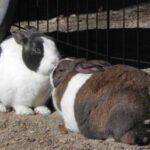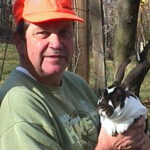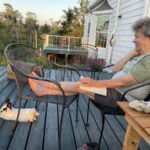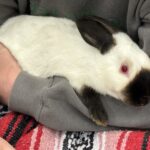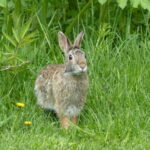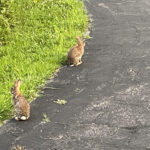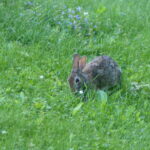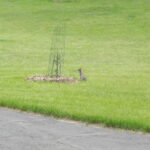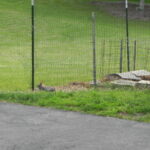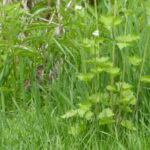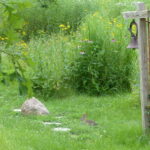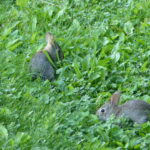
Young rabbits “play” to gain skills and show dominance.
Have you noticed the abundance of the cottontail rabbit this summer? While they can create mischief as in eating desired plants, they also are fun to watch.
Winding Pathway’s resident cottontail rabbits give us delightful evening entertainment. Shortly after sunset, a few appear like magic from out of our labyrinth’s tall prairie. As we sit on our porch they scamper about, chase each other, and nibble on the white clover poking out of our lawn.
Many people dislike cottontails for their habit of feasting on favored garden plants and gnawing on tree bark in the winter. Because we enjoy both rabbits and Swiss Chard, we keep them away from our vegetables and, thus, appreciate their antics.
Several cottontail species range across most of the United States, southern Canada, and South America. They’re well adapted to thrive in diverse environments. Ours is the Eastern Cottontail rabbit. This year they are especially abundant.
There are Rabbits and Then There are Rabbits
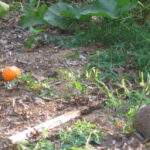
Side by side
Cottontails and common domestic pet rabbits may look similar but they are vastly different.
Pet Bunnies
Pet bunnies trace their ancestry to Europe and were domesticated thousands of years ago. They make fascinating and loveable pets and thrive in a safe roomy hutch eating commercial pellets. These are the rabbits that were released in Australia and caused enormous agricultural and ecological damage. They readily breed, are social, and join others to dig a series of burrows called warrens. Some readers may remember the award-winning novel, Watership Down, and the Netflix series about precocious rabbits.
- Children and adults enjoy bunnies.
- Rabbits are social.
- Friendly pets
- European rabbits adapt to people
- Show animals.
- Children with rabbits
Cottontail Rabbits
Cottontails, in contrast, are wild animals that rarely, if ever, become tame or make good pets. Like European rabbits they are social and like the company of other bunnies but not people. Cottontails don’t make burrows but sometimes enjoy ducking down an abandoned woodchuck hole. Cottontails live under dense vegetation, in culverts, and under outbuildings. They eat a wide range of wild plants but love snacking on vegetables. In winter they sometimes eat the bark off young trees. So, be sure to protect your young trees with wire mesh around the base.
- Time for an evening snack.
- bunny play
- Nibbling clover
Enjoying Both Cottontails and Vegetables
Years ago, we learned a trick that lets us enjoy our resident cottontails and abundance from the garden. European rabbits are high jumpers, but not cottontails. Instead, native bunnies are long jumpers who can’t jump high. Just a wimpy two-foot-tall chicken wire fence around the garden or a young tree keeps them away as long as they can’t get under it.
- Keep rabbits away from young trees.
- Cottontails cannot jump high.
Why So Many Cottontails This Year
For the past few years, Iowa has been in drought. It limited the new tender growth of clovers and other delectable plants that bunnies love. Sparse rain thinned thickets where they hide. This year’s been wet. Vegetation is tender and abundant yet we’ve not had big early thunderstorms. Why’s that important to a cottontail?
Before giving birth, a cottontail digs a shallow hole in the ground, often near the edge of a lawn. She lines it with fur and soon deposits three to eight tiny blind helpless babies. Mom mostly stays away but nurses them in the morning or evening by sitting over the burrow and letting her babies nurse. They grow amazingly fast and are out on their own when only about three weeks old. Mom soon gets ready for another litter.
Who Doesn’t Love a Cottontail Rabbit?
Predators love rabbits. They’re a favorite meal for dogs, cats, raptors, snakes, foxes, and coyotes. There are always rabbits because their survival strategy is to have many babies, even though only a small percent reach adulthood and reproduce.
Getting Rid of Cottontails
Well, why do it? They are inquisitive and beautiful animals that share yards with people.
An easy solution is to run chicken wire around desirable plants to keep them away. So, people can have their plants and rabbits, too.
Hooray for bunnies! They brighten our evenings as they scamper about our yard.
- Rabbits know to stay hidden
- Cottontails live in the labyrinth.
- Nibbling clover


